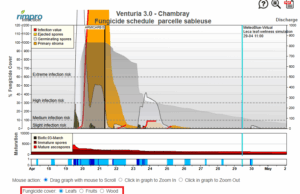How can I interpret the fungicide cover in RIMpro?
Decline of previous spray cover is caused by plant growth and rainfall. It is expressed as a gray layer. In the lower right corner of the graph you can select to see the development of the fungicide cover on growing shoots, fruits, or stem and branches.
- Leaf cover shows the cover of the youngest, most susceptible, leafs. When the surface of these leafs doubles, the cover is reduced by 50%. In the same time a new uncovered leaf initial develops. Plant growth has more effect on the decline of fungicide cover of the susceptible leafs than rainfall.
- Fruit cover shows the cover of the fruits. During summer relative increase of fruit skin surface declines, and fungicide cover holds longer. Rainfall gets more important than fruit growth.
- Wood cover shows the cover of wooden parts of the tree. This information is only relevant for the RIMpro Apple Canker model. Decline of wood cover is depending on rainfall only. ‘Wash-off’ of fungicides by rainfall is depending on the product. The expert-estimated amount of rainfall that washes of 50% of the product can be found in the fungicide table that you find under ‘Parameters’ in the main menu.
The reach of post infection efficacy of curative fungicides is calculated and expressed as gray layer. Depending on the fungicide, it can stop infecting spores until a defined stage in their development. Because spore development is depending on temperature, the post infection reach of fungicides in the fungicide table is indicated in Degree Hours post-infection
The presented development of fungicide cover is our best estimate. Under field conditions fungicide cover is affected by spraying conditions, sprayer qualities, and canopy characteristics. Even under the best conditions there is a considerable variation between the best and worst covered part of the canopy.
Decline of fungicide cover means increase of insufficiently covered plant surface. With that, the chance that spores infect on surface that is not protected increases. The infection risk increases further with inoculum potential (=absolute spore number), and infection severity. In orchards with high inoculum potential, and during severe infection events, less uncovered plant parts can be tolerated. In these situations fungicide cover should be higher during infection development.

Our practical experience is that fungicide cover during the germination window should:
- Always be over 30%.
- For more severe infections over 50%.
- For infections with extreme infection risk two applications are necessary. Before and during germination window, or an additional post-infection treatment. This is not to put on more and different chemistry, but to make with two successive spray rounds sure that no part of the canopy stays uncovered.